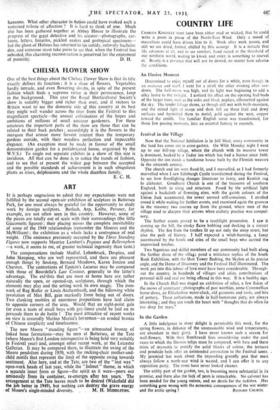ART
IT is perhaps ungracious to admit that my expectations were not fulfilled by the second open-air exhibition of sculpture in Battersea Park, for one must always be grateful for the opportunity to study work by foreign sculptors. Barlach, Arp, Kolbe, Pevsner, for example, are not often seen in this country. However, some of the pieces are totally out of scale with their surroundings (the little Giacometti figures) ; their placing misses the complete inevitability of some of the 1949 relationships (remember the Moores and the McWilliam) ; the exhibition as a whole lacks a centrepiece of real weight. (The eminence previously occupied by the Three Standing Figures now supports Maurice Lambert's Pegasus and Bellerophon —a work, it seems to me, of greater technical ingenuity than taste.)
The compensations include Maillol, Lehmbruck, Despiau, and John Skeaping, who are well represented, and there are pleasant enough things by Soukop, Bernard Meadows, Karen Jonzen and Charoux. The contortions of Epstein's Lazarus may be compared with those of Bourdelle's Last Centaur, generally to the latter's advantage. The ext•ibits that are most at home here are rather naturally the open, or opened-up, sculptures, through which the elements may play and the setting work its own magic. The iron- work of Reg Butler or Louis Archambault, and the billowing white involution of Max Bill, gain markedly from being out of doors. Two clanking mobiles of enormous proportions have laid claim to opposite corners of the area. Would that an eight-point gale (or even a team of small boys with guy-lines) could be laid on to persuade them to do battle I The most attractive of recent works on view is assuredly Marino Marini's horseman—an eroded bronze of Chinese simplicity and timelessness.
The new Moore "standing figure "—an attenuated bronze of linked bone formations—may be seen at Battersea, at the Tate (where Moore's first London retrospective is being held very suitably in Festival year) and, amongst other recent work, at the Leicester Galleries. It may be compared there, to illustrate the swing of the Moore pendulum during 1950, with the rocking-chair mother-and- child motifs that represent the limit of the opposite swing towards sentiment. Also here, and at the Tate, are two of the "lost wax" open-work heads of last year, while the " helmet " theme, in which a separate inner form or figure—the spirit as it were—peers out ominously from its container, re-emerges after ten years. The arrangement at the Tate leaves much to be desired (Wakefield did the job better in 1949), but nothing can destroy the grave energy of Moore's single-minded diversity. , M. H. MIDDLEroN.


































 Previous page
Previous page